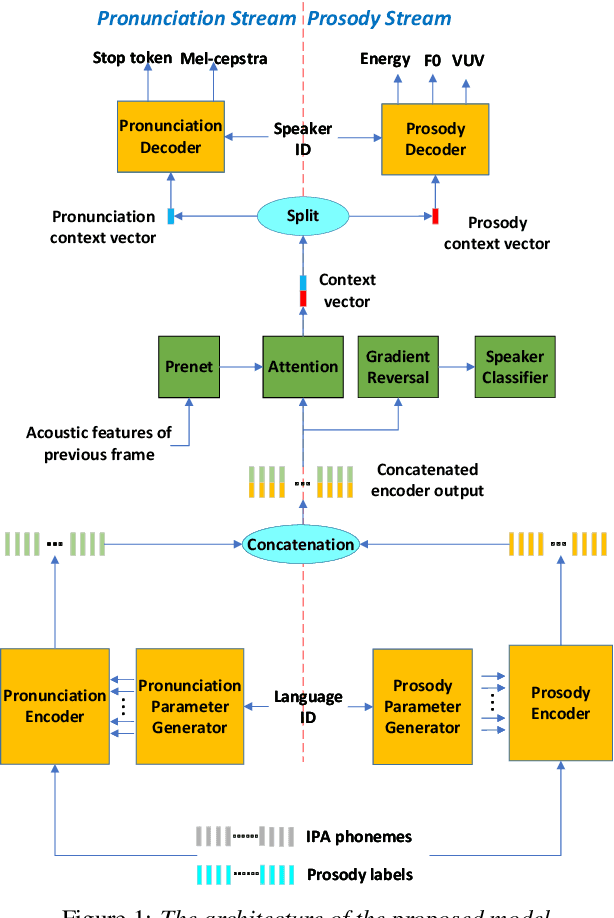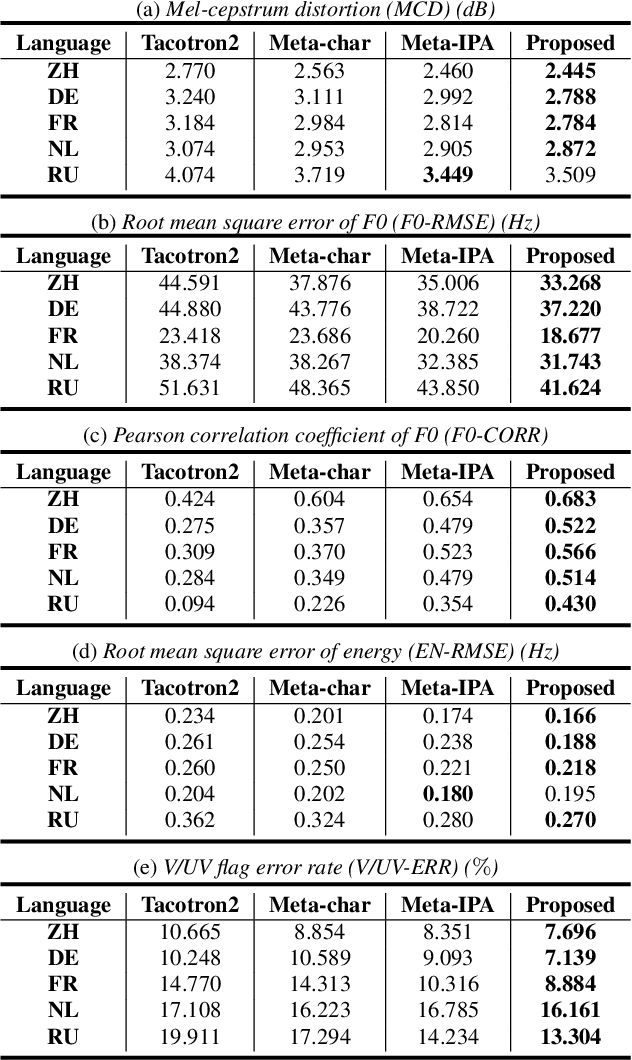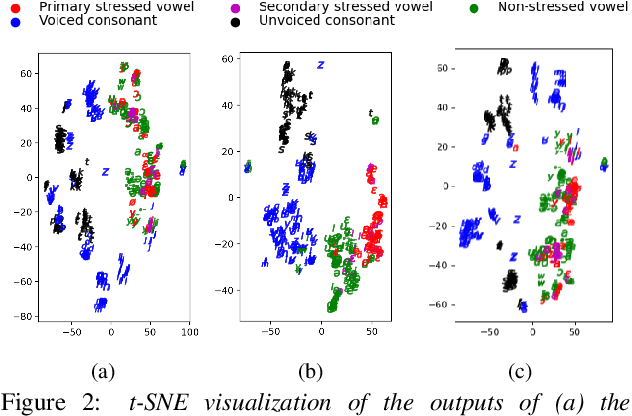Zhenhua Ling
The CCF AATC 2025: Speech Restoration Challenge
Sep 16, 2025Abstract:Real-world speech communication is often hampered by a variety of distortions that degrade quality and intelligibility. While many speech enhancement algorithms target specific degradations like noise or reverberation, they often fall short in realistic scenarios where multiple distortions co-exist and interact. To spur research in this area, we introduce the Speech Restoration Challenge as part of the China Computer Federation (CCF) Advanced Audio Technology Competition (AATC) 2025. This challenge focuses on restoring speech signals affected by a composite of three degradation types: (1) complex acoustic degradations including non-stationary noise and reverberation; (2) signal-chain artifacts such as those from MP3 compression; and (3) secondary artifacts introduced by other pre-processing enhancement models. We describe the challenge's background, the design of the task, the comprehensive dataset creation methodology, and the detailed evaluation protocol, which assesses both objective performance and model complexity. Homepage: https://ccf-aatc.org.cn/.
Pinhole Effect on Linkability and Dispersion in Speaker Anonymization
Aug 23, 2025Abstract:Speaker anonymization aims to conceal speaker-specific attributes in speech signals, making the anonymized speech unlinkable to the original speaker identity. Recent approaches achieve this by disentangling speech into content and speaker components, replacing the latter with pseudo speakers. The anonymized speech can be mapped either to a common pseudo speaker shared across utterances or to distinct pseudo speakers unique to each utterance. This paper investigates the impact of these mapping strategies on three key dimensions: speaker linkability, dispersion in the anonymized speaker space, and de-identification from the original identity. Our findings show that using distinct pseudo speakers increases speaker dispersion and reduces linkability compared to common pseudo-speaker mapping, thereby enhancing privacy preservation. These observations are interpreted through the proposed pinhole effect, a conceptual framework introduced to explain the relationship between mapping strategies and anonymization performance. The hypothesis is validated through empirical evaluation.
Select to Know: An Internal-External Knowledge Self-Selection Framework for Domain-Specific Question Answering
Aug 21, 2025



Abstract:Large Language Models (LLMs) perform well in general QA but often struggle in domain-specific scenarios. Retrieval-Augmented Generation (RAG) introduces external knowledge but suffers from hallucinations and latency due to noisy retrievals. Continued pretraining internalizes domain knowledge but is costly and lacks cross-domain flexibility. We attribute this challenge to the long-tail distribution of domain knowledge, which leaves partial yet useful internal knowledge underutilized. We further argue that knowledge acquisition should be progressive, mirroring human learning: first understanding concepts, then applying them to complex reasoning. To address this, we propose Selct2Know (S2K), a cost-effective framework that internalizes domain knowledge through an internal-external knowledge self-selection strategy and selective supervised fine-tuning. We also introduce a structured reasoning data generation pipeline and integrate GRPO to enhance reasoning ability. Experiments on medical, legal, and financial QA benchmarks show that S2K consistently outperforms existing methods and matches domain-pretrained LLMs with significantly lower cost.
RISE: Reasoning Enhancement via Iterative Self-Exploration in Multi-hop Question Answering
May 28, 2025Abstract:Large Language Models (LLMs) excel in many areas but continue to face challenges with complex reasoning tasks, such as Multi-Hop Question Answering (MHQA). MHQA requires integrating evidence from diverse sources while managing intricate logical dependencies, often leads to errors in reasoning. Retrieval-Augmented Generation (RAG), widely employed in MHQA tasks, faces challenges in effectively filtering noisy data and retrieving all necessary evidence, thereby limiting its effectiveness in addressing MHQA challenges. To address these challenges, we propose RISE:Reasoning Enhancement via Iterative Self-Exploration, a novel framework designed to enhance models' reasoning capability through iterative self-exploration. Specifically, RISE involves three key steps in addressing MHQA tasks: question decomposition, retrieve-then-read, and self-critique. By leveraging continuous self-exploration, RISE identifies accurate reasoning paths, iteratively self-improving the model's capability to integrate evidence, maintain logical consistency, and enhance performance in MHQA tasks. Extensive experiments on multiple MHQA benchmarks demonstrate that RISE significantly improves reasoning accuracy and task performance.
UDDETTS: Unifying Discrete and Dimensional Emotions for Controllable Emotional Text-to-Speech
May 15, 2025Abstract:Recent neural codec language models have made great progress in the field of text-to-speech (TTS), but controllable emotional TTS still faces many challenges. Traditional methods rely on predefined discrete emotion labels to control emotion categories and intensities, which can't capture the complexity and continuity of human emotional perception and expression. The lack of large-scale emotional speech datasets with balanced emotion distributions and fine-grained emotion annotations often causes overfitting in synthesis models and impedes effective emotion control. To address these issues, we propose UDDETTS, a neural codec language model unifying discrete and dimensional emotions for controllable emotional TTS. This model introduces the interpretable Arousal-Dominance-Valence (ADV) space for dimensional emotion description and supports emotion control driven by either discrete emotion labels or nonlinearly quantified ADV values. Furthermore, a semi-supervised training strategy is designed to comprehensively utilize diverse speech datasets with different types of emotion annotations to train the UDDETTS. Experiments show that UDDETTS achieves linear emotion control along the three dimensions of ADV space, and exhibits superior end-to-end emotional speech synthesis capabilities.
DiffStyleTTS: Diffusion-based Hierarchical Prosody Modeling for Text-to-Speech with Diverse and Controllable Styles
Dec 04, 2024



Abstract:Human speech exhibits rich and flexible prosodic variations. To address the one-to-many mapping problem from text to prosody in a reasonable and flexible manner, we propose DiffStyleTTS, a multi-speaker acoustic model based on a conditional diffusion module and an improved classifier-free guidance, which hierarchically models speech prosodic features, and controls different prosodic styles to guide prosody prediction. Experiments show that our method outperforms all baselines in naturalness and achieves superior synthesis speed compared to three diffusion-based baselines. Additionally, by adjusting the guiding scale, DiffStyleTTS effectively controls the guidance intensity of the synthetic prosody.
Refining Self-Supervised Learnt Speech Representation using Brain Activations
Jun 12, 2024



Abstract:It was shown in literature that speech representations extracted by self-supervised pre-trained models exhibit similarities with brain activations of human for speech perception and fine-tuning speech representation models on downstream tasks can further improve the similarity. However, it still remains unclear if this similarity can be used to optimize the pre-trained speech models. In this work, we therefore propose to use the brain activations recorded by fMRI to refine the often-used wav2vec2.0 model by aligning model representations toward human neural responses. Experimental results on SUPERB reveal that this operation is beneficial for several downstream tasks, e.g., speaker verification, automatic speech recognition, intent classification.One can then consider the proposed method as a new alternative to improve self-supervised speech models.
Adversarial speech for voice privacy protection from Personalized Speech generation
Jan 22, 2024Abstract:The rapid progress in personalized speech generation technology, including personalized text-to-speech (TTS) and voice conversion (VC), poses a challenge in distinguishing between generated and real speech for human listeners, resulting in an urgent demand in protecting speakers' voices from malicious misuse. In this regard, we propose a speaker protection method based on adversarial attacks. The proposed method perturbs speech signals by minimally altering the original speech while rendering downstream speech generation models unable to accurately generate the voice of the target speaker. For validation, we employ the open-source pre-trained YourTTS model for speech generation and protect the target speaker's speech in the white-box scenario. Automatic speaker verification (ASV) evaluations were carried out on the generated speech as the assessment of the voice protection capability. Our experimental results show that we successfully perturbed the speaker encoder of the YourTTS model using the gradient-based I-FGSM adversarial perturbation method. Furthermore, the adversarial perturbation is effective in preventing the YourTTS model from generating the speech of the target speaker. Audio samples can be found in https://voiceprivacy.github.io/Adeversarial-Speech-with-YourTTS.
Pre-training Language Model as a Multi-perspective Course Learner
May 06, 2023



Abstract:ELECTRA, the generator-discriminator pre-training framework, has achieved impressive semantic construction capability among various downstream tasks. Despite the convincing performance, ELECTRA still faces the challenges of monotonous training and deficient interaction. Generator with only masked language modeling (MLM) leads to biased learning and label imbalance for discriminator, decreasing learning efficiency; no explicit feedback loop from discriminator to generator results in the chasm between these two components, underutilizing the course learning. In this study, a multi-perspective course learning (MCL) method is proposed to fetch a many degrees and visual angles for sample-efficient pre-training, and to fully leverage the relationship between generator and discriminator. Concretely, three self-supervision courses are designed to alleviate inherent flaws of MLM and balance the label in a multi-perspective way. Besides, two self-correction courses are proposed to bridge the chasm between the two encoders by creating a "correction notebook" for secondary-supervision. Moreover, a course soups trial is conducted to solve the "tug-of-war" dynamics problem of MCL, evolving a stronger pre-trained model. Experimental results show that our method significantly improves ELECTRA's average performance by 2.8% and 3.2% absolute points respectively on GLUE and SQuAD 2.0 benchmarks, and overshadows recent advanced ELECTRA-style models under the same settings. The pre-trained MCL model is available at https://huggingface.co/McmanusChen/MCL-base.
Decoupled Pronunciation and Prosody Modeling in Meta-Learning-Based Multilingual Speech Synthesis
Sep 14, 2022



Abstract:This paper presents a method of decoupled pronunciation and prosody modeling to improve the performance of meta-learning-based multilingual speech synthesis. The baseline meta-learning synthesis method adopts a single text encoder with a parameter generator conditioned on language embeddings and a single decoder to predict mel-spectrograms for all languages. In contrast, our proposed method designs a two-stream model structure that contains two encoders and two decoders for pronunciation and prosody modeling, respectively, considering that the pronunciation knowledge and the prosody knowledge should be shared in different ways among languages. In our experiments, our proposed method effectively improved the intelligibility and naturalness of multilingual speech synthesis comparing with the baseline meta-learning synthesis method.
 Add to Chrome
Add to Chrome Add to Firefox
Add to Firefox Add to Edge
Add to Edge